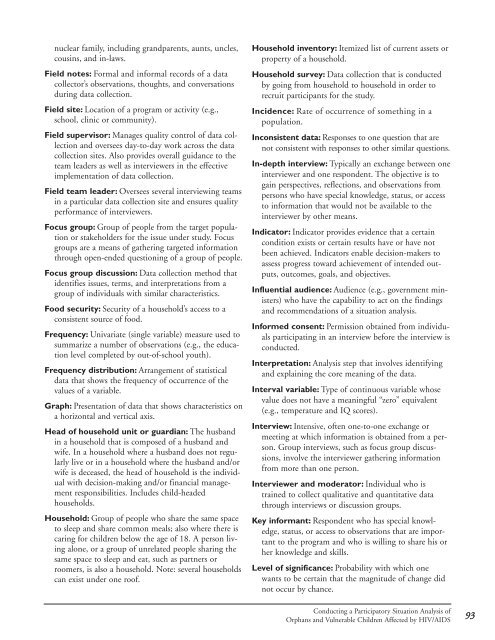Conducting a Participatory Situation Analysis of.pdf - Global HIV ...
Conducting a Participatory Situation Analysis of.pdf - Global HIV ...
Conducting a Participatory Situation Analysis of.pdf - Global HIV ...
You also want an ePaper? Increase the reach of your titles
YUMPU automatically turns print PDFs into web optimized ePapers that Google loves.
nuclear family, including grandparents, aunts, uncles,<br />
cousins, and in-laws.<br />
Field notes: Formal and informal records <strong>of</strong> a data<br />
collector’s observations, thoughts, and conversations<br />
during data collection.<br />
Field site: Location <strong>of</strong> a program or activity (e.g.,<br />
school, clinic or community).<br />
Field supervisor: Manages quality control <strong>of</strong> data collection<br />
and oversees day-to-day work across the data<br />
collection sites. Also provides overall guidance to the<br />
team leaders as well as interviewers in the effective<br />
implementation <strong>of</strong> data collection.<br />
Field team leader: Oversees several interviewing teams<br />
in a particular data collection site and ensures quality<br />
performance <strong>of</strong> interviewers.<br />
Focus group: Group <strong>of</strong> people from the target population<br />
or stakeholders for the issue under study. Focus<br />
groups are a means <strong>of</strong> gathering targeted information<br />
through open-ended questioning <strong>of</strong> a group <strong>of</strong> people.<br />
Focus group discussion: Data collection method that<br />
identifies issues, terms, and interpretations from a<br />
group <strong>of</strong> individuals with similar characteristics.<br />
Food security: Security <strong>of</strong> a household’s access to a<br />
consistent source <strong>of</strong> food.<br />
Frequency: Univariate (single variable) measure used to<br />
summarize a number <strong>of</strong> observations (e.g., the education<br />
level completed by out-<strong>of</strong>-school youth).<br />
Frequency distribution: Arrangement <strong>of</strong> statistical<br />
data that shows the frequency <strong>of</strong> occurrence <strong>of</strong> the<br />
values <strong>of</strong> a variable.<br />
Graph: Presentation <strong>of</strong> data that shows characteristics on<br />
a horizontal and vertical axis.<br />
Head <strong>of</strong> household unit or guardian: The husband<br />
in a household that is composed <strong>of</strong> a husband and<br />
wife. In a household where a husband does not regularly<br />
live or in a household where the husband and/or<br />
wife is deceased, the head <strong>of</strong> household is the individual<br />
with decision-making and/or financial management<br />
responsibilities. Includes child-headed<br />
households.<br />
Household: Group <strong>of</strong> people who share the same space<br />
to sleep and share common meals; also where there is<br />
caring for children below the age <strong>of</strong> 18. A person living<br />
alone, or a group <strong>of</strong> unrelated people sharing the<br />
same space to sleep and eat, such as partners or<br />
roomers, is also a household. Note: several households<br />
can exist under one ro<strong>of</strong>.<br />
Household inventory: Itemized list <strong>of</strong> current assets or<br />
property <strong>of</strong> a household.<br />
Household survey: Data collection that is conducted<br />
by going from household to household in order to<br />
recruit participants for the study.<br />
Incidence: Rate <strong>of</strong> occurrence <strong>of</strong> something in a<br />
population.<br />
Inconsistent data: Responses to one question that are<br />
not consistent with responses to other similar questions.<br />
In-depth interview: Typically an exchange between one<br />
interviewer and one respondent. The objective is to<br />
gain perspectives, reflections, and observations from<br />
persons who have special knowledge, status, or access<br />
to information that would not be available to the<br />
interviewer by other means.<br />
Indicator: Indicator provides evidence that a certain<br />
condition exists or certain results have or have not<br />
been achieved. Indicators enable decision-makers to<br />
assess progress toward achievement <strong>of</strong> intended outputs,<br />
outcomes, goals, and objectives.<br />
Influential audience: Audience (e.g., government ministers)<br />
who have the capability to act on the findings<br />
and recommendations <strong>of</strong> a situation analysis.<br />
Informed consent: Permission obtained from individuals<br />
participating in an interview before the interview is<br />
conducted.<br />
Interpretation: <strong>Analysis</strong> step that involves identifying<br />
and explaining the core meaning <strong>of</strong> the data.<br />
Interval variable: Type <strong>of</strong> continuous variable whose<br />
value does not have a meaningful “zero” equivalent<br />
(e.g., temperature and IQ scores).<br />
Interview: Intensive, <strong>of</strong>ten one-to-one exchange or<br />
meeting at which information is obtained from a person.<br />
Group interviews, such as focus group discussions,<br />
involve the interviewer gathering information<br />
from more than one person.<br />
Interviewer and moderator: Individual who is<br />
trained to collect qualitative and quantitative data<br />
through interviews or discussion groups.<br />
Key informant: Respondent who has special knowledge,<br />
status, or access to observations that are important<br />
to the program and who is willing to share his or<br />
her knowledge and skills.<br />
Level <strong>of</strong> significance: Probability with which one<br />
wants to be certain that the magnitude <strong>of</strong> change did<br />
not occur by chance.<br />
<strong>Conducting</strong> a <strong>Participatory</strong> <strong>Situation</strong> <strong>Analysis</strong> <strong>of</strong><br />
Orphans and Vulnerable Children Affected by <strong>HIV</strong>/AIDS<br />
93















